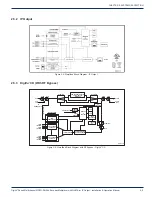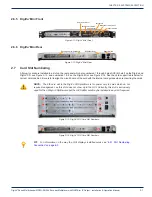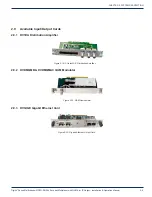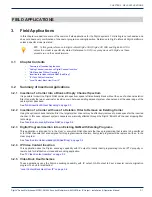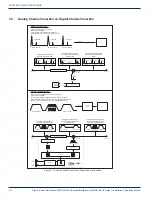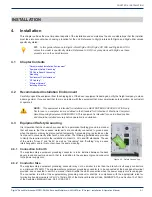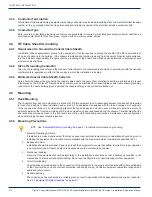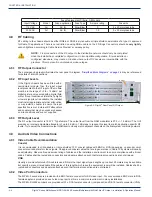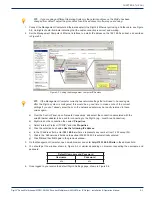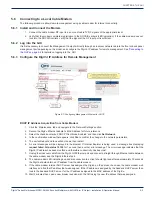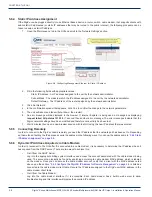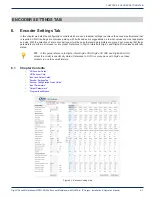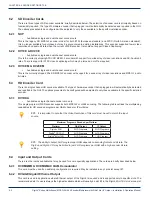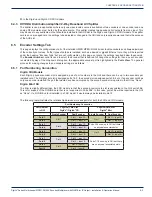
CHAPTER 4: INSTALLATION
DigiVu
®
Series Multichannel MPEG-2/H.264 Encoder/Multiplexer with QAM &/or IP Output - Installation & Operation Manual
4-3
4.6 Environment Considerations
4.6.1 Ambient Temperature
The chassis must be installed in a room where the ambient air temperature does not exceed +122°F (+50°C). This is a
maximum temperature that must not be exceeded but the preferred temperature range is one where people feel most
comfortable.
4.6.2 Non-condensing Environment
The environment must be non-condensing. This means that a relative humidity of less than 95% must be maintained. Lower
humidity is better and the preferred humidity range is one where people feel most comfortable.
4.6.3 Fan Control
The equipment is designed to operate to specification in an ambient room temperature of 0°C to +50°C (+32°F to +122°F).
Sufficient airflow through the unit must be maintained regardless of the mounting location. It is imperative that other equipment
or materials of any type do not block free airflow at the front and top/back of the chassis. There are no internal air filters so
there is no need to provide ongoing maintenance of filters.
4.7 Provisioning Electrical Power
4.7.1 Power Cord Protection
Measures must be taken during installation to route or arrange the power supply cord to prevent physical damage to the
cord and to avoid the possibility of future damage occurring. The power supply cord shall be installed and routed such that,
throughout it’s length, the cord and it’s points of connection are not strained in any way.
4.7.2 Power Cord Attachment:
The power supply cord shall not be attached to the building surface, bundled with audio, video or RF coaxial cables, nor run
through walls, ceilings, floors and similar openings in the building structure.
4.7.3 Provision of Electrical Power Outlet:
An electrical power outlet of appropriate type and rating shall be provided near the location where the chassis is installed such
that the provided power supply cord may be routed in an appropriate manner, without the use of extension cords, between the
receptacle and the chassis. Alternately, the chassis shall be installed in close proximity to an existing electrical outlet such that
the requirements of this paragraph are achieved.
4.7.4 IEC Power Input Cord
The power input receptacle is a standard IEC connector similar to that commonly used on computers and monitors. The power
cord provided is dependant on the shipping address of the equipment. If shipped in North America a cord with a NEMA 5-15
grounded plug for 115 VAC is provided. If it is necessary to operate the equipment on 230 VAC, the installer must obtain an
IEC cord with a NEMA 6-15 grounded plug for use in North America. This may be obtained from ATX Networks or locally. If
shipped outside of North America, the equipment will be shipped with an IEC cord set appropriate for the locale.
4.7.5 Input Power Requirements
When installing equipment, it is the responsibility of the installer to determine that sufficient capacity is available in the electrical
circuit feeding the unit to avoid overloading the supply circuit. Each model will require power according to it’s specifications to
be supplied from a properly grounded outlet. The installer should determine that the power outlet, its wiring and receptacle is
in compliance with the local electrical codes.
4.7.6 Input Power
The input power requirement is constant over the range of input voltages. At higher input voltages, the current consumption is
lower than it is at lower voltages where the input current is higher.
4.7.7 Input Voltage Range
The equipment is supplied with an autosensing switching type power supply which can operate on input voltages from 90 VAC
to 264 VAC. There is no need to configure the power supply to operate on any voltage within this range.
4.7.8 Fusing
The internal power supply is protected from over current conditions with a slow blow fuse. Replace with similar type and rating
to avoid over-current circuit damage. The following table describes the fuse if replacement ever becomes necessary.

